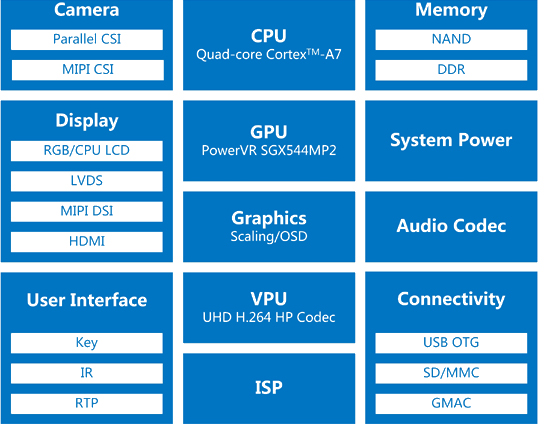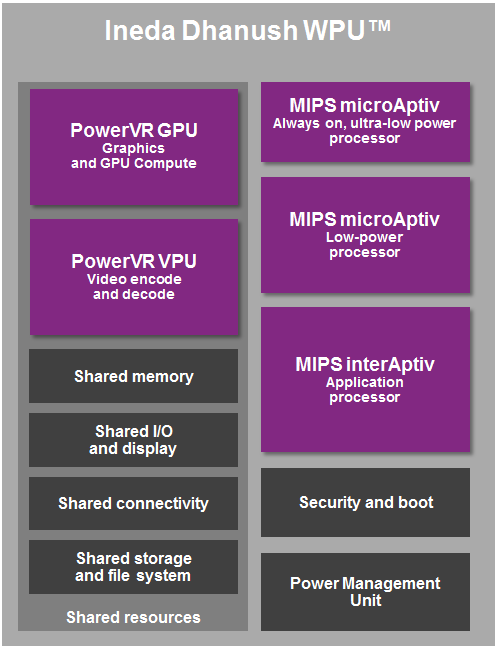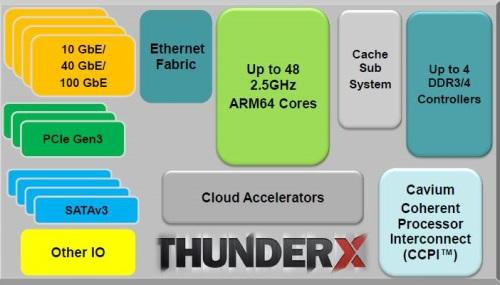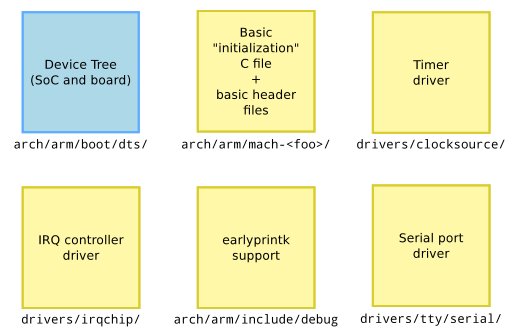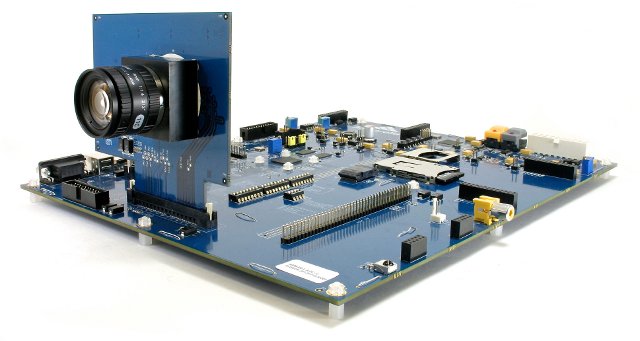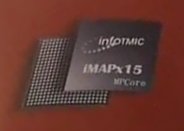AllWinner A-series that can be found in tablets and media players are pretty well known, but AllWinner also has V-Series processors with V10 and V15. A first glance, AllWinner V10 is quite similar to AllWinner A31 with a quad core Cortex A7 CPU coupled with a PowerVR SGX544MP2 GPU, and AllWinner V15 has the same CPU/GPU combo as AllWinner A10 (CortexA8/Mali-400). But AllWinner V-Series are actually video encoders targeting applications such as IP cameras, car DVRs, and sports digital video cameras thanks to features such as motion detection, video scaling, and digital watermarking. Let’s go through AllWinner V10 specifications, and I’ll mark differences with AllWinner A31, or features not mentioned in A31 specs, in bold: CPU – Quad-core ARM Cortex-A7 with· 256KB L1 cache, 1MB L2 cache GPU – PowerVR SGX544MP2 compliant with OpenCL 1.1 EP and delivering up to 20GFLOPS. Memory – 32-bit DDR3/LPDDR2 SDRAM controller, supporting up to […]
Ineda Systems Dhanush WPU is a MIPS based SoC Specifically Designed for Wearables
What’s a WPU? It stands for Wearable Processor Unit, and as you may guess it’s a processor specifically designed to be used in wearables such as smartwatches or fitness trackers. Currently, many wearables are based on application processors that are used in smartphones (e.g. Galaxy Gear), and lower-end versions are based on standard low power MCUs (e.g. Pebble), but none of them are actually based on SoC specifically designed for wearables, and analysts are asserting that new types of SoC are definitely needed if companies are to provide wearables with the battery life and features consumers want. Ineda Systems Dhanush WPU is not the first Wearable SoC announced, as for instance AllWinner mentioned their WX quad-core SoC for Wearables should become available in Q4 2014 in their roadmap, and Mediatek vaguely unveiled their Aster SoC at CES 2014, but it’s the first that I know of where we’ve got most of the […]
Cavium ThunderX Server SoC Features up to 48 ARM 64-bit Cores
ARM SBSA specification for server supports up to 268,435,456 CPU cores for the second level of standardization on one or a combination of SoCs. We’re not quite up there just yet, but Cavium ThunderX is an ARM server SoC with up to 48 cores on a single chip, which is the highest number of cores I’ve ever heard of in an ARM SoC. The company created their own custom processor cores using an ARMv8 architecture license, designing an SoC complies with ARM’s Server Base System Architecture (SBSA) standard with the following key features: ARM based SoC that scales up from 8 to 48 cores with up to 2.5 GHz core frequency with 78K I-Cache, 32K D-Cache, and 16MB L2 cache. Fully cache coherent across dual sockets using Cavium Coherent Processor Interconnect (CCPI) Integrated I/O capacity with 100s of Gigabits of I/O bandwidth 4x DDR3/4 72-bit memory controllers supporting up to 1TB RAM […]
Your New ARM SoC Linux Support Check-List – ELCE 2012
Thomas Petazzoni, embedded Linux engineer and trainer at Free Electrons, describes the steps he followed to add a new Marvell SoC to the mainline kernel at ELCE 2012. Abstract: Since Linus Torvalds raised warnings about the state of the ARM architecture support in the Linux kernel, a huge amount of effort and reorganization has happened in the way Linux supports ARM SoCs. From the addition of the device tree to the pinctrl subsystem, from the new clock framework to the new rules in code organization and design, the changes have been significant over the last one and half year in the Arm Linux kernel world. Based on the speaker’s experience on getting the support for the new Marvell Armada 370 and Armada XP SoC support in the mainline Linux kernel, we will give an overview of those changes and summarize the new rules for ARM Linux support. We aim at […]
Ambarella Unveils A9 4K Ultra HD Camera SoC
Ambarella has recently today introduced the A9 camera System on Chip (SoC) with support for the new 4K Ultra HD video standard in order to power next generation of mirrorless, sports, and digital still cameras. Ambarella A9 SoC features two ARM Cortex A9 cores (surprisingly), as well as Ambarella Image and Video DSPs. The A9’s video features include video timelapse modes, capture of high-resolution still images during video recording, Electronic Image Stabilization (EIS), and burst capture of up to sixty 12-megapixel still images per second. Ultra-wide angle and small form factor lenses are supported with full lens distortion correction. The A9 also support High Dynamic Range (HDR) video. Ambarella A9 Feature Summary: 4K Ultra HD video recording @ 30 fps. High definition video recording at 720p @ 240fps and 1080p @ 120fps. Burst mode support for still image capture of over 700 Megapixels per second. Multi-exposure High Dynamic Range (HDR) […]
InfoTMIC iMAPx15 Dual Cortex-A5 SoC To Power $35 Android Tablets
InfoTMIC has recently launched the iMAPx15 SoC featuring 2 Cortex A5 and a Mali-400 GPU. Infotmic iMAPx15 is a low cost version of iMAPx820 that is cost optimized for tablets, and lacks features such as SATA and GPS. Charbax interviewed InfoTMIC marketing director at CES 2013, where they discussed the new processor, and showcased a 7″ Android 4.1 tablet powered by iMAPx15 that is said to cost just $35. The device is not sold on Chinese websites yet, so I could not confirm this claim. At first, I thought it would be unlikely to be the retail price, but there are some 7″ Android tablets selling for about $40 on Aliexpress (Update: The sellers at this price don’t have feedback, so those could be scams). So the $35 price tag could either be the unit price for 1K orders or the retail price in China. iMAPx15 is not listed on […]
Intel Announces 3 Atom S1200 Low Power Server SoCs: S1220, S1240 and S1260
Intel has recently introduced the Intel Atom S1200 product family (Codename: Centerton) targeting high-density microservers (1000+ nodes per rack), and energy-efficient storage and networking systems. These new processors includes features such as error code correction, 64-bit support, and virtualization technologies required for use inside data centers, and consume as low as 6.1 watts. Three models are currently available: Intel Atom S1220 @ 1.6 GHz – TDP 8.1 Watts Intel Atom S1240 @ 1.6 GHz – TDP 6.1Watts Intel Atom S1260 @2.0 GHz – TDP 8.5Watts The SoCs include 2 physical cores and 4 threads enabled with Hyper-Threading Technology. The SoCs also include 64-bit support, a memory controller supporting up to 8GB of DDR3 memory, Intel Virtualization Technologies (Intel VT), 8 lanes of PCI Express 2.0, Error-Correcting Code (ECC) support, and other I/O interfaces integrated from Intel chipsets. Atom S1200 processors are manufactured using 32nm process technology. Intel also announced that […]
MediaTek Unveils Quad-Core Cortex-A7 MT6589 SoC
This December is a busy month for silicon manufacturers and Cortex A7 processor, after AllWinner A20 and A31, Rockchip RK3188 (4x Cortex A9), Qualcomm MSM8226 & MSM8626, Broadcom BCM21664T (2x Cortex A9), MediaTek announced MT6589, a quad-core Cortex A7 System on a Chip (SoC) with Imagination Technologies PowerVR Series5XT GPU that targets mid to high-end Android smartphones and tablets. Mediatek MT6589 also integrates a multi-mode UMTS Rel. 8/HSPA+/TD-SCDMA modem developed in-house, Mediatek’s 4-in-1 connectivity combo (802.11n Wi-Fi, BT4.0, GPS and FM), and a multimedia subsystem that supports 1080p 30fps/30fps low-power video playback and recording, a 13MP Camera with Integrated ISP, up to FHD (1920×1080) LCD displays, and enhanced picture processing for DTV-grade image quality. This SoC also features MediaTek’s “Cool 3D” suite for support for stereo 3D cameras and displays & real-time 2D-to-3D, as well as support for Miracast technology. The first devices based on MediaTek MT6589 should be available […]


